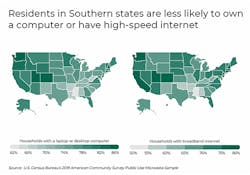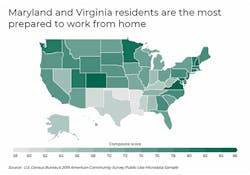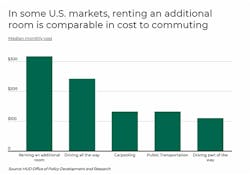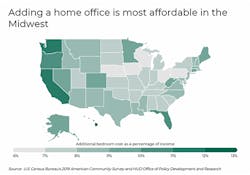Latest from Home
Recent updates include notices from HighSpeedInternet.com, Kong Inc, Nintex, Filterbuy, and Parks Associates.
Visit https://isemag.com/category/safety/telecom-covid-19-network-impact-wireless-wireline/ often to find more COVID-19 Impact Updates.
Landmark Research Addresses The Impact of COVID-19 on Consumer Technology and Home Services Markets
45,000,000 US broadband households engaged in remote work or schooling
Landmark research from Parks Associates, which measures the impact of the COVID-19 pandemic on consumer attitudes and behaviors regarding connected home technologies, reveals that over 90% of US broadband households report making a significant change to their lifestyle to avoid catching COVID-19 and to limit its spread.
Parks Associates also finds that 51% of US broadband households bought at least one consumer electronics product between February and September 2020, including computing, networking, entertainment, and mobile devices.
COVID-19: Impact on Consumer Behavior and Spending finds that as of September 2020, 41% of US broadband households, representing 45,000,000 households, were engaged in remote work or remote schooling. 62% of remote workers are using their home broadband more than usual, nearly double the rate of non-remote workers.
“With record-high unemployment, household spending is primarily on essential goods, as uncertainty about the future remains high,” said Elizabeth Parks, President, Parks Associates. “Some technology products are viewed as essential tools. Companies have changed how they interact with their customers — leveraging e-commerce channels, offering new curbside pick-up and delivery options, and providing remote rather than in-home technical support services.”
The research examines the key segments, consumer desires and attitudes, current ownership rates, and planned purchases across connected living markets. Key findings and market insights from the research include the following:
• The overall churn rate for OTT services dropped to 38%, down from 46% a year ago.
• COVID-19 has prompted roughly 33% of security system owners and intenders to avoid professional installers.
• 24% of households with fixed broadband service report they are likely to upgrade in the next 6 months.
• 60% of pay-TV subscribers are interested in content from an online video service as part of their pay-TV subscription.
• Use of telehealth services jumped from 15% in 2Q 2019 to 41% in 2Q 2020.
• More than 15 million US households have only a mobile broadband service, including more than 12 million that cut the cord on their home broadband and approximately 3,000,000 that have never had home broadband services.
• NPS for mobile phone providers trends significantly higher than NPS for pay-TV and internet service providers, with Boost Mobile and T-Mobile leading the way.
This research series leverages Parks Associates’ ongoing consumer surveys of 10,000 US broadband households per quarter, as well as targeted surveys of 5,000, to identify trends and deliver ongoing insights into how consumers are responding COVID-19, including the impact to market fundamentals and product purchases, service subscriptions and usage, and home services.
Titles in this series:
• COVID-19: Impact on Consumer Behavior and Spending
• COVID-19: Impact on Communications and Entertainment
• COVID-19: Impact on Residential Security and Smart Home
• COVID-19: Impact on Seniors, Caregivers, and Independent Living Solutions
• COVID-19: Impact on Telehealth and Independent Living
The firm also released COVID-19 Contact Tracing: Consumer Perspectives, available to download for free at http://www.parksassociates.com/whitepapers/contacttracing.
For more information on COVID-19: Impact on Consumer Behavior and Spending, contact [email protected].
About the Author: Parks Associates, a woman-founded and certified business, is an internationally recognized market research and consulting company specializing in emerging consumer technology products and services. http://www.parksassociates.com
More Than 12 Million US Households Have Cut the Cord on Their Home’s Broadband Service
New research from Parks Associates reports more than 12 million US households have cancelled their home broadband service and use only mobile broadband for their Internet needs. Adoption and Perception of Broadband finds there are more than 15 million households in the US that have only a mobile broadband service, which includes more than 3,000,000 households that have never had a home Internet subscription.
“High cost is the most prominent issue driving households to cut the cord and go mobile only, although service-related issues, from slow speeds to poor customer experience, also contribute,” said Kristen Hanich, Senior Analyst, Parks Associates. “Service providers can deploy a number of strategies, including increasing speed and delivering a device that improves Wi-Fi coverage, in order to protect their customer base.”
InvisiLight® Solution for Deploying Fiber
April 2, 2022Go to Market Faster. Speed up Network Deployment
April 2, 2022Episode 10: Fiber Optic Closure Specs Explained…
April 1, 2022Food for Thought from Our 2022 ICT Visionaries
April 1, 2022Adoption and Perception of Broadband finds that smart Wi-Fi or mesh networking products that would improve Wi-Fi coverage are powerful incentives to staunch churn, as 75% of households likely to switch would stay with their current provider if offered these solutions. Currently 94% of all US broadband households use Wi-Fi networking at home, and more than half report problems with their Internet experience.
The user experience and the ability to deliver the necessary speeds are more critical now — as of September 2020, 41% of US broadband households were engaged in remote work or remote schooling. The increase in at-home activity has renewed consumers’ focus on their broadband speeds.
“In September 2020, 9% of US broadband households had upgraded their home’s broadband service in the previous 12 months, and the COVID-19 crisis was the main reason for 80% of those upgrades,” Hanich said. “Overall the NPS scores for all service providers have increased from 2019 to 2020. Good performance during the COVID-19 crisis has improved customers’ opinion of their service providers, but there were dips throughout the year, indicating that providers need to continue to deliver on customer service and innovate in value-added offerings in order to grow and maintain their subscriber base.”
Parks Associates surveys 10,000 US broadband households each quarter, providing a rich data set with trending for at least 5 years.
About the Author: Parks Associates, a woman-founded and certified business, is an internationally recognized market research and consulting company specializing in emerging consumer technology products and services. http://www.parksassociates.com
51% of Tech Leaders Give Companies Lagging in Digital Innovation Only 3 Years or Less to Live, a 14% Jump from the Prior Year
One year into the COVID-19 pandemic, new research from Kong Inc. shows the importance of digital innovation has dramatically increased. According to the 2021 Digital Innovation Benchmark report, 51% of technology leaders expect a business to go under or be acquired by 2024 if they lag in digital innovation, up from 37% in Kong’s inaugural 2020 report. A shocking 84% predict this dire outcome within 6 years.
62% of technology leaders across industries believe competitors could displace them by being quicker to innovate, up from 57% in the prior year. The survey of 400 technology leaders benchmarks the use of modern software architectures to enable business agility and compares how they are being used at organizations with 1,000+ employees. This year’s research also explores the role the COVID-19 pandemic is having on digital transformation plans and technology budgets.
Technology leaders face immense pressure to future-proof their organizations’ infrastructure so it can support the technologies, applications and business models of the future. Like last year, a large majority of these professionals (87%) say the failure to adopt microservices will hurt their company’s ability to compete. In the wake of the COVID-19 pandemic, 67% of them expect serious professional ramifications — being fired, losing out on a promotion or missing out on a bonus — for failed modernization initiatives (e.g., cloud, microservices, adopting new technologies).
Open Source, Microservices, and Kubernetes Power Digital Innovation
Developers favor open source software and the freedom to test-drive innovative technologies that are designed for today’s needs. It is no surprise that open source is prevalent among the overwhelming majority of organizations surveyed (91%). The US leads in the use of open source, where 94% of technology leaders say that their organizations have been using or just started to use open source software, compared with 89% in Europe. The types of open source technologies used most include: databases (57%), infrastructure automation (47%), API design, testing and automation (46%), and API gateway (38%) and containers (38%), which are enabling technologies to develop, deploy and manage applications with distributed architectures based on microservices.
Open source service mesh is a new type of software that companies are starting to use today (20%), fueled by high enterprise adoption of microservices, and is new to Kong’s research this year. The vast majority of companies (87%) are already using microservices. 33% have transitioned entirely to distributed architectures, including microservices and serverless, with the highest adoption in France and the US. (40% and 39% respectively) Of those already using or planning to use microservices, the average number in production is 102 across all regions. The average is significantly higher in the US than in Europe: 129 versus 74.
The main reasons (beyond cost) that are driving enterprises to transition to microservices include:
• Increase security (63%)
• Integrate new tech faster (59%)
• Increase speed of development (57%)
• Increase infrastructure flexibility (52%)
Kong’s research this year also explored current and planned adoption of Kubernetes. 865 of organizations are already using or planning to use the open source container orchestration system, with only 5% with no plans to do so in the next 12 months. This data demonstrates that Kubernetes has emerged as the standard operating environment for applications built with modern distributed architectures.
Mixed Deployment Environments Add Complexity and New Security Risks
The challenges of using distributed applications and architectures extend to a range of deployment options across on-premises, hybrid cloud, public cloud or multi-cloud. Nearly half (46%) are running services on-premises that connect with services running in the cloud. Among respondents, use of Amazon Web Services (43%) has a slight lead over Microsoft Azure (42%), followed by Google Cloud Platform (35%, up from 27% the prior year). Forty-one percent of companies currently use a multi-cloud environment, defined as services running in one cloud connected with services running in another cloud.
With the diversity of applications running across heterogeneous environments, it comes as no surprise that managing APIs is a growing problem. The top challenges include securing APIs (51%), monitoring API traffic (42%), scaling APIs (39%), API performance (36%), controlling API traffic (35%) and testing (35%) APIs.
When asked about specific challenges in using microservice-based applications, the top reasons cited include:
• Security issues (37% overall)
• Complexity of managing services across platforms (32%)
• Connecting all services to create an end-to-end digital experience (29%)
• Communication among various teams working on different microservices (26%)
• Difficulty integrating existing monoliths with microservices (23%, down from 32% the prior year)
“A year into the pandemic has made it clear that ‘business as usual’ is a thing of the past. It’s no surprise that a company’s ability to digitally innovate will largely determine whether it will survive or be displaced in a few short years,” said Marco Palladino, CTO and co-founder of Kong. “Our research shows that technology leaders understand that speed of innovation must also be matched with security, operational efficiency and reliability. As infrastructure and applications become more distributed and interconnected, the ability to connect and secure data as it travels across services and through clouds is vital.”
COVID-19 Pandemic Accelerates Existing Trends
Technology leaders overwhelmingly agree (89%) that creating new digital experiences to address COVID-19 business challenges is a business-critical endeavor. 64% of respondents say they will continue to pursue multi-year digital transformation initiatives. When asked about the impact the pandemic has had on their company’s IT/developer budget over the last 12 months, 55% of respondents reported an increase. 27% of respondents in France say their budget has increased 25% or more, compared with the US (21%), UK (16%), and Germany (14%).
Funding Innovation and Speed in 2021
Organizations recognize that while fast innovation is essential to stay competitive in 2021, speed cannot come at the expense of other fundamentals. When asked to rank business priorities, improve operational efficiency (39%), improve application performance/reliability (37%) and improve application security (35%) were deemed higher priorities than reduce cost (33%) and accelerate innovation (27%). The vast majority of U.S. (81%) and European (78%) companies are increasing their IT budgets in the coming year, with 21% of U.S. companies expecting their budgets to grow by 26% or more, compared with only 16% in Europe.
To download the full report, visit https://konghq.com/resources/digital-innovation-benchmark-2021/.
Resources:
• Full report and interactive assessment
• Infographic
• Blog post
About the Survey: Kong engaged Vanson Bourne to field a survey of 400 senior technology decision makers in the U.S. and Europe, including CIOs, CTOs, VPs of IT, IT directors/architects and software engineers/developers from organizations across a range of industries. The survey was fielded in December 2020-January 2021, with respondents coming from a range of industries, including business and professional services; financial services; IT, technology and telecoms; manufacturing and production; and retail, distribution and transport. Vanson Bourne rigorously screened interview candidates to ensure suitability and data quality
About the Company: Kong creates software and managed services that connect APIs and microservices natively across and within clouds, Kubernetes, data centers and more using intelligent automation. Built on an open source core, Kong’s service connectivity platform enables digital innovation by allowing organizations to reliably and securely manage the full lifecycle of APIs and services for modern architectures, including microservices, serverless and service mesh. For more information about Kong, please visit https://konghq.com/ or follow @thekonginc on Twitter.
Vanson Bourne is an independent specialist in market research for the technology sector. For more information, visit www.vansonbourne.com.
34% of Smart Home Device Owners Report Having Technical Problems Within the Last 12 Months
Recent research from Parks Associates’ Shifting Support Needs: Opportunities for Remote Solutions reveals one-third of smart home device owners report having technical problems within the last 12 months. A loss of wireless connectivity is the most common problem experience, followed by having an unresponsive device. Shifting Support Needs: Opportunities for Remote Solutions tracks consumer experience with connected devices and highlights specific pain points with leading product categories throughout the consumer journey, from purchase to ongoing use.
“Just under 20% of smart home device owners report having a smart home device professionally installed by the company that sold them the product, and 16% report hiring a contractor to set up a device,” said Patrice Samuels, Senior Analyst, Parks Associates. “As smart home device manufacturers attempt to drive market growth, keeping product prices low is essential. Therefore, many have embraced DIY setup strategies that minimize overall consumer product costs.”
The consumer study reveals 65% of consumers who self-installed their smart home devices would prefer to self-install devices in the future. This finding is consistent with the percentage of consumers reporting preference to set up their devices themselves in the future in 2018 and 2019. Consumer preference to set up devices on their own validates the increasing use of DIY setup strategies among device manufacturers and helps these manufacturers save on support costs.
The research also finds the percentage of consumers experiencing technical problems has more than doubled since 2018, with 34% of smart home device owners experiencing at least one technical problem within the last 12 months. Given the high costs associated with providing in-home support, smart home device manufacturers must embrace sophisticated remote tools that reduce the need for in-home support. Additionally, 45% of consumers are now more hesitant to allow technicians in their home.
“Remote technical support channels are increasingly important, given the social distancing guidelines brought on by the COVID-19 crisis. While the type of remote support available to consumers will vary based on the problem they experience, it remains important to understand consumers’ preferences,” Samuels said.
About the Author: Parks Associates, a woman-founded and certified business, is an internationally recognized market research and consulting company specializing in emerging consumer technology products and services. http://www.parksassociates.com
Parks Associates surveys 10,000 US broadband households each quarter, providing a rich data set with trending for at least 5 years. For more information, contact [email protected]. To schedule an interview with an analyst or to request specific research data, please contact Rosey Ulpino at [email protected], 972.996.0233.
Nintex Workplace 2021 Study Reveals That Work Is Getting Done Faster From Home
Nintex, the global standard for process management and automation, released findings from the Nintex Workplace 2021 Study revealing that a majority of employees working remotely during the COVID-19 pandemic in the United States have been more productive than they expected, with many reporting a desire for automation to further boost productivity from their home office.
In a survey of 1,000 U.S.-based full-time American workers at companies with 501-50,000 employees, Nintex found that 70% of those surveyed report that their experiences working from home have been better and more productive than they expected, citing more family time, no commute, fewer interruptions, and improved work-life balance. While the majority of employees reported getting work done more efficiently since transitioning to full-time remote work, more than a third (37%) are calling for their companies to adopt automation software to make them even more productive.
“Every organization can improve the experiences for their employees, regardless of where they work, by simply automating workflows and turning paper-based and repetitive processes into fully digital ones,” said Nintex Chief Marketing & Strategy Officer Dustin Grosse. “Employees across every job role and generation are looking for workplaces that are flexible and offer automation tools that make work faster, easier, and more enjoyable.”
The report, which gauges employee sentiment on important remote work topics, also provides insight into the eventual return to the office, generational gaps, and what employees want in order to do their jobs better.
HIGHLIGHTS from the study include:
• Work is getting done faster at home. 67% of employees report being more efficient since transitioning to full-time remote work. Of those respondents, 41% — the largest group — said they are getting their work done in far fewer hours now per week.
• Say "goodbye" to monotonous work. Software solutions are in high demand, with 39% of respondents saying access to software that helps them automate manual and repetitive tasks would improve their work life in 2021.
• Boomers want a raise, Zoomers want automation. Whereas Baby Boomers are more financially motivated, the new generation of workers is more process driven. Boomers feel more compensation would improve their work. Gen Zers, however, desire more technology to help them automate aspects of their work. In fact, 55% of Gen Z respondents listed automation software as the top thing that would make them more productive at work.
• Employees are split on the return to the office. Despite positive experiences working from home, 56% of employees whose companies have announced plans to return to the office are very excited by the prospect. Yet, half (50%) of all respondents said their work life would improve with the ability to permanently work remotely.
“Business leaders around the country recognize that we will not go back to the way things were before the COVID-19 pandemic,” Grosse said. “The Nintex Workplace 2021 Study shines a light on the new work paradigm and offers actionable insights into what employees want — a more flexible workplace where automation is leveraged to improve the way people work.”
To download the complete report, visit www.nintex.com/workplace-2021-study.
METHODOLOGY
The findings reported in the Nintex Workplace 2021 Study are the result of a commissioned survey conducted by Lucid in September 2020. The survey comprises responses from 1,000 U.S.-based full-time enterprise employees working remotely and gauges employee sentiment toward the evolving workplace. The respondent pool included employees from organizations with anywhere from 500 to more than 50,000 employees, and included employees across ranks, from coordinators to C-suite executives. For a complete breakdown visit www.nintex.com/workplace-2021-study.
About the Author: Nintex is the global standard for process management and automation. Today more than 10,000 public and private sector organizations across 90 countries turn to the Nintex Platform to accelerate progress on their digital transformation journeys by quickly and easily managing, automating and optimizing business processes. Learn more by visiting www.nintex.com and experience how Nintex and its global partner network are shaping the future of Intelligent Process Automation (IPA).
Cities Most Prepared to Work From Home
A new study from Filterbuy looks at the locations in the US that are most prepared to work from home. In addition to having the hardware and internet access in order to work remotely, having a suitable home workspace is associated with increased telework satisfaction and self-reported productivity. Researchers ranked metropolitan areas according to a composite score that was generated by looking at a variety of factors, including the percentage of workers in remote-friendly jobs, the percentage of households with computer access and broadband Internet, and the percentage of households with a spare bedroom that could be used as a home office.
To access the original report, which includes a table with data on more than 250 metros and all 50 states, visit https://filterbuy.com/resources/cities-most-prepared-to-work-from-home/.
Since March of 2020, the COVID-19 pandemic has caused record numbers of Americans to transition to remote work. As COVID cases have surged across the country, recent CDC guidelines suggest that workers should be allowed to work remotely if they can.
While many jobs are suitable to a remote work environment, most are not. Using data from the Census Bureau as well as a recent study by University of Chicago researchers, about 31% of U.S. workers are employed in remote-friendly jobs, but this varies substantially on a geographic level.
Additionally, not everyone who works in an occupation that can be performed remotely is well-positioned to do so.
Differences in computer and high-speed Internet access, as well as available space in the household, all impact an individual’s preparedness for remote work.
Working from home typically requires both a computer and a high-speed Internet connection. According to data from the Census Bureau, nearly a quarter of US households don’t own a computer and close to 30% lack broadband internet, such as cable, fiber optic, or DSL.
• Not surprisingly, owning a computer and having high-speed Internet tend to go hand in hand.
• At the state level, states where more households own computers are also home to more households with high-speed Internet.
• On a regional level, the South is less prepared to work from home — Southern states tend to have lower rates of home computer ownership and fewer households with broadband Internet.
In addition to having the necessary hardware and Internet access, being able to create a clear boundary between your home life and work life can make all the difference when working from home.
Having a suitable home workspace is associated with increased telework satisfaction and self-reported productivity. Workers with a spare bedroom at home will find it easier to create a dedicated workspace than those whose only option is a shared living area, such as the kitchen or dining room table. For example, while the San Francisco metropolitan area is home to a disproportionate number of laptop workers with high-speed Internet access, a majority of these workers don’t have extra space for a home office, making full-time remote work more challenging in the Bay Area than in areas with more affordable housing.
To find the most prepared places in the U.S. to work from home, researchers at Filterbuy analyzed data from the U.S. Census Bureau and the University of Chicago. They created a composite telework preparedness score based on the following factors:
• Percentage of workers in remote-friendly jobs
• Percentage of households with a laptop or desktop computer
• Percentage of households with broadband Internet, such as cable, fiber optic or DSL
• Percentage of households with at least 1 spare bedroom that could be used as a home office
• Median number of rooms per person in each household
At the state level, many of the most-prepared states to work from home are on the East Coast.
• The 2 states flanking Washington, D.C., Maryland and Virginia, rank the highest in the country according to the composite score.
• Over one-third of jobs in each of these states can be performed from home, and a large proportion of households in both states have computers and high-speed internet access.
The South tends to be less prepared to work from home.
• Arkansas ranks the lowest in the country according to its composite score.
• Just 26% of jobs in Arkansas can be performed from home, while less than two-thirds of Arkansas households own computers.
• Only 56% of Arkansas households have high-speed Internet.
METHODOLOGY
To find the metropolitan areas in the U.S. most prepared to work from home, researchers at Filterbuy ranked metro areas according to their composite score. To improve relevance, only metropolitan areas with at least 100,000 people were included in the analysis. Additionally, metro areas were grouped into the following cohorts based on population size:
• Small metros: 100,000–349,999
• Midsize metros: 350,000–999,999
• Large metros: 1,000,000 or more
To access the original report, which includes a table with data on more than 250 metros and all 50 states, visit https://filterbuy.com/resources/cities-most-prepared-to-work-from-home/.
The Most Affordable Cities to Size Up for a Home Office
A new study conducted by Filterbuy looks at the most affordable U.S. metropolitan areas to size up for a home office. As a result of the pandemic, more Americans are working from home than ever before, but not everyone has the extra space for a home office. On average, sizing up to an apartment with an additional bedroom costs about 9% of monthly income, but some locations are more affordable than others. Researchers ranked metros across the country according to the average cost to size up for an additional bedroom as a percentage of income.
To access the original report, which includes a table with data on more than 350 metros and all 50 states, visit: https://filterbuy.com/resources/affordable-cities-for-home-office/
One of the COVID-19 pandemic’s biggest impacts on the labor market has been the remarkable shift to working from home. While working from home is not new, the U.S. has never seen remote work at the current scale. A recent Gallup poll from the fall shows that a whopping 58% of U.S. workers were working remotely at least part of the time, yet many lacked sufficient space at home to do so effectively.
Having a dedicated home office can help remote workers be more productive, and sizing up to an apartment with space for a home office may be worthwhile for workers who plan to continue working remotely. However, depending on rent prices and income, renting a larger space is more affordable in some cities than others. According to income data on renters from the U.S. Census Bureau and rent prices from the Department of Housing and Urban Development (HUD), sizing up to an apartment with an additional bedroom costs about 9 percent of monthly income, on average.
An obvious advantage of working from home is not commuting, which saves valuable time and money. Data from HUD shows that commuters who drive the entire way to work spend a median of $242 each month on commuting costs. Carpoolers and those who take public transportation spend less — $132 monthly at the median — while those who drive part of the way (while also using another mode of transportation such as public transportation, walking, or cycling) spend the least at $110 per month. According to fair market rent data from HUD, the median monthly cost of an additional bedroom in the U.S. is $317, meaning upgrading to a larger apartment could be close to cost-neutral for workers in more affordable areas with long and expensive commutes.
Due to geographic differences in rent and median earnings, it is more feasible to rent an additional bedroom in some places than in others. Sizing up is most affordable in the Midwest. In Wisconsin and Nebraska, an additional bedroom costs $215–$220 per month, or just 6.6 percent of monthly income for renters. Sizing up is least affordable in California and Hawaii where adding a bedroom costs an additional $531–$672 per month, or 11.2 and 13.3 percent of income, respectively.
To find the most affordable locations to size up for a home office, researchers at Filterbuy analyzed the latest data from the U.S. Census Bureau’s 2019 American Community Survey and the Department of Housing and Urban Development (HUD). The researchers ranked metro areas according to the cost of an additional bedroom as a percentage of renter income. Researchers also calculated median monthly rent for a 1-bedroom, 2-bedroom, 3-bedroom, and 4-bedroom apartment.
To improve relevance, only metropolitan areas with at least 100,000 people were included in the analysis. Additionally, metro areas were grouped into the following cohorts based on population size:
• Small metros: 100,000-349,999
• Midsize metros: 350,000-999,999
• Large metros: more than 1,000,000
For more information, a detailed methodology, and complete results, you can find the original report on Filterbuy’s website: https://filterbuy.com/resources/affordable-cities-for-home-office/













